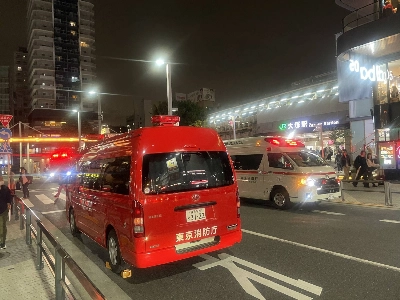The use of solar energy to generate power and to heat water is gradually spreading in Japan, but the most basic use of sunshine is yet to come out of the shadows — namely, for lighting.
To save on the amount of electricity that is used for lighting rooms, a venture company recently introduced a unique blind that allows diffused daylight to enter a room, thus saving on the use of electric lights.
Hiro Okahashi, director of United Solar Guide, Inc. in Tokyo, explained that each of the Solarguide's plastic slats has four chambers, of which three have different micro nicks on the surfaces. When daylight from random angles strikes the blind, the slats diffuse and redirect the sunshine to illuminate the room uniformly.
In addition, when daylight comes into a room through the window, photo sensors that can be attached to the ceiling measure the brightness and controllers automatically turn down any lights, thus minimizing the use of electric lights, according to Okahashi.
"By using the blind and the light- control system, 80 to 90 percent of electricity for light is saved on a sunny day," Okahashi said.
Putting theory into practice, however, in February, Otis Co., a mobile-phone parts maker in Okayama Prefecture, installed USG's window shades in its meeting room. Since then, said the company's president Shuichi Sayama, there has been an 84.3 percent saving in the power used to light the room during the day. In addition to that, the average temperature in the room has gone down by 0.8 degrees, Sayama said, due to the fact that normal metal blinds absorb the sun's heat and release it into the room, whereas the Solarguide blinds are made of plastic and become a form of insulation.
"The temperature reduction led to a saving on the use of air conditioning of 10 to 20 percent," Sayama said, adding that he is considering fitting the system to other rooms in the company's building.
According to the Energy Conservation Center, Japan, an organization under the jurisdiction of the Natural Resources and Energy Agency, electricity used for lights and through power sockets accounts for 36 percent of the electricity consumed in offices, followed by that used for air conditioning, at 26 percent.
"There are many rooms in offices where there is a strong possibility that much of the power used for lighting and air conditioning could be similarly saved," said Nobuyuki Tanaka, an official at the center.
Okahashi of USG said the company is now promoting its blinds in Japan and California, with its 1.22×2.4-meter model priced at ¥30,000 here and its 4-foot-wide model selling for $200 to $300 in the United States, depending on the height of the window.
For an 80-sq.-meter room with windows totaling 8 meters in width, three blinds, three photo sensors, a remote controller and 18 lights with dimmer controls are needed — at a total outlay of ¥247,350, according to Okahashi. With another ¥173,340 estimated for installation, the system's total cost then becomes ¥420,690 — meaning it pays for itself in 5.2 years at current power prices.
As to why the company chose to target California for its sales, Okahashi said that the public, the power companies and local governments there are more eager to promote energy saving than those in Japan, partly because the state experienced an electricity supply crisis that led to widespread blackouts in 2000 and 2001.
In 2005, the state of California established a new mandatory energy code, which requires new buildings to be equipped with photo sensors and dimming lighting systems to minimize the use of electric lights by utilizing daylight.
Okahashi said the regulations make it easier for the company to promote sales of its blinds, as new buildings in The Golden State are already equipped with the necessary lighting systems to make use of the window shades.
To further promote energy saving, utilities in California also rebate cash to customers who purchase energy-efficient electrical appliances to replace ordinary models (and who install attic insulation as well), while local governments reduce their tax demands depending on the amount of energy saved, Okahashi said, portraying this as an enlightened "carrot-and-stick" approach by the authorities.
But in Japan, he ruefully remarked, such measures to reward energy savers have not been introduced, and this lack of incentives discourages companies and households from reducing their use of power.
"In most office buildings here, bright electric lights are on from morning to night. It is clear that we are wasting power for lighting during the day," Okahashi said.
"It is an urgent task to create a low-carbon society. So we should take every possible measure in our daily lives to save energy."




















With your current subscription plan you can comment on stories. However, before writing your first comment, please create a display name in the Profile section of your subscriber account page.